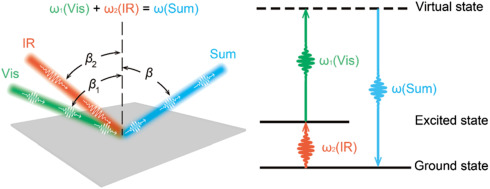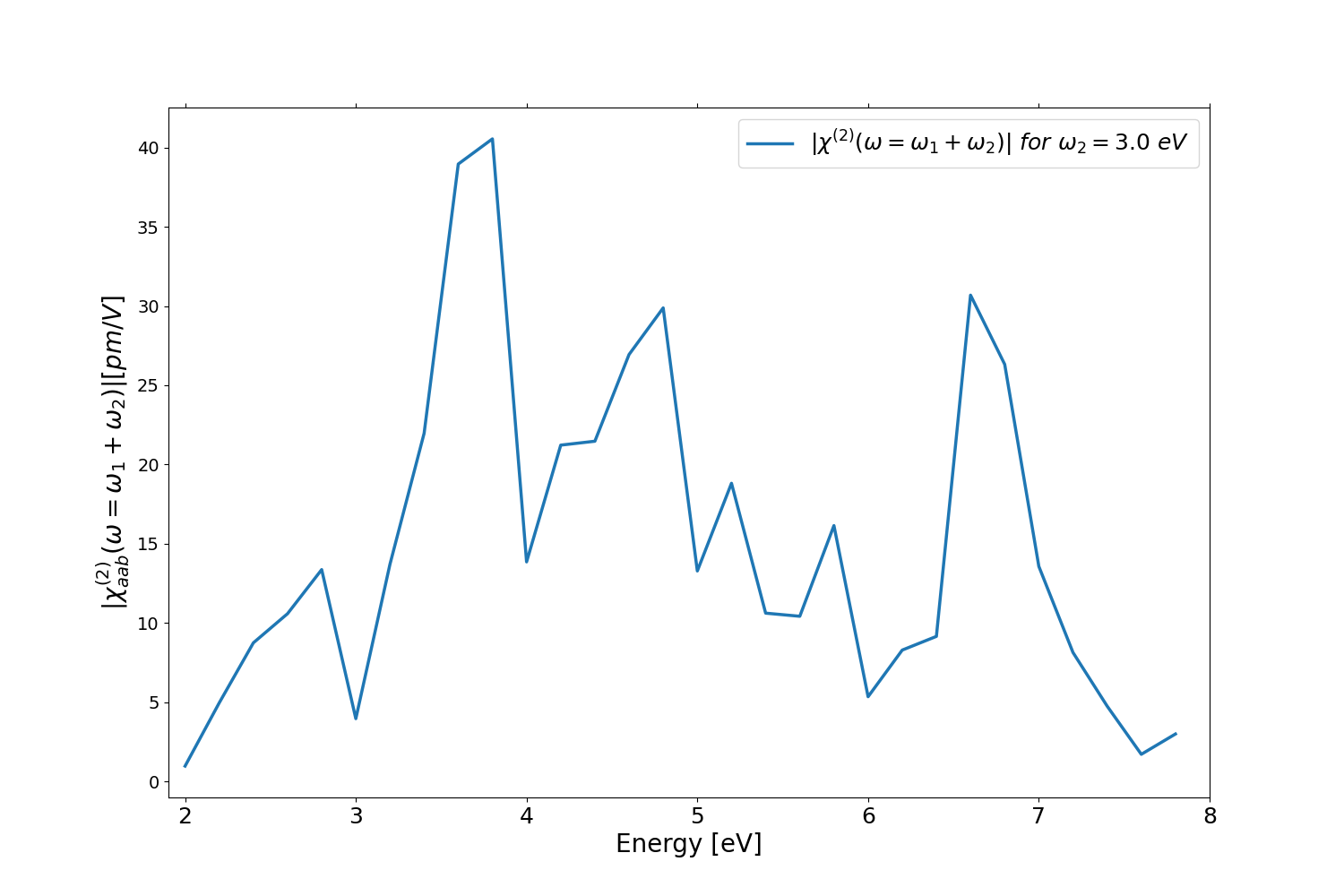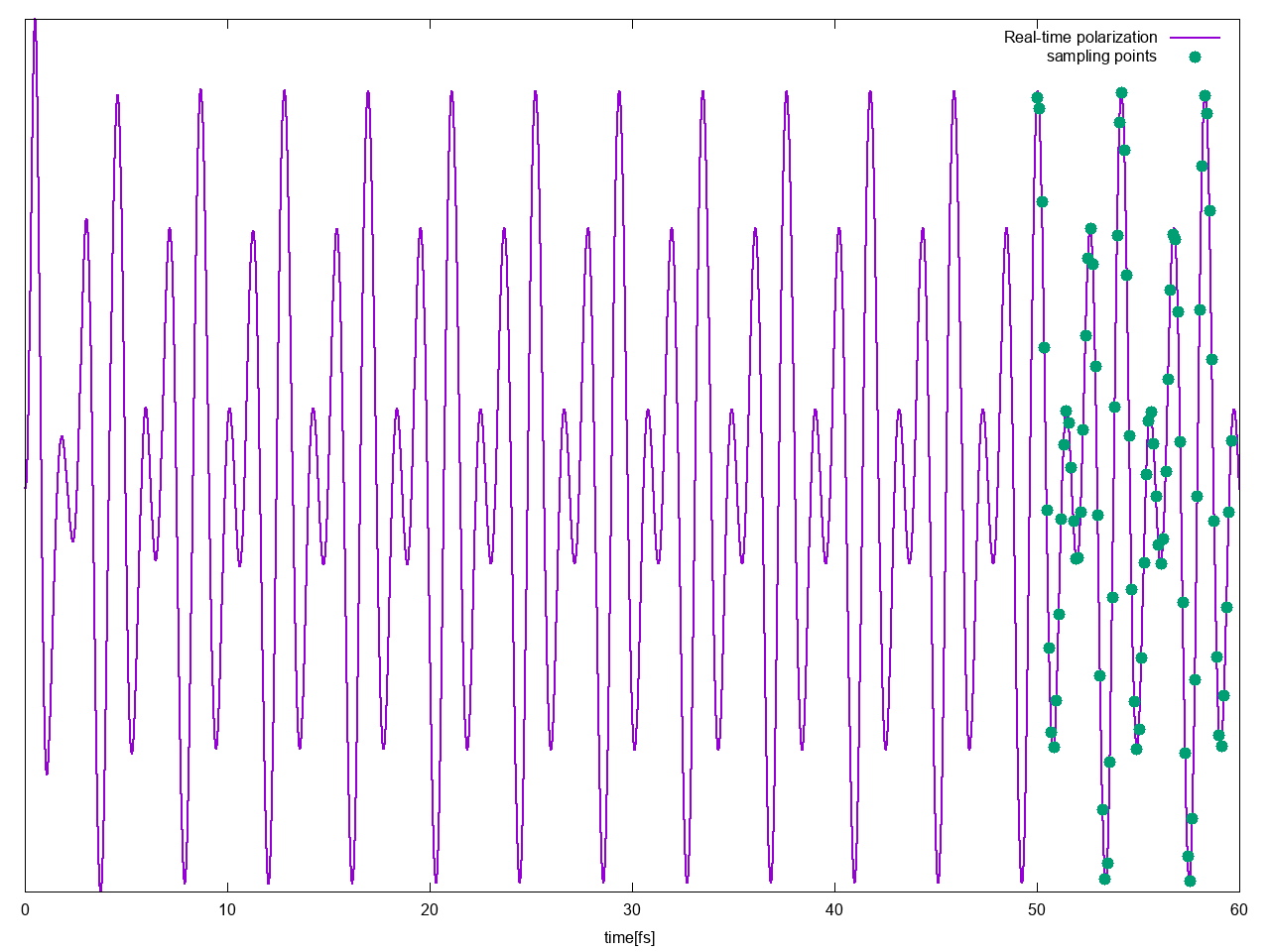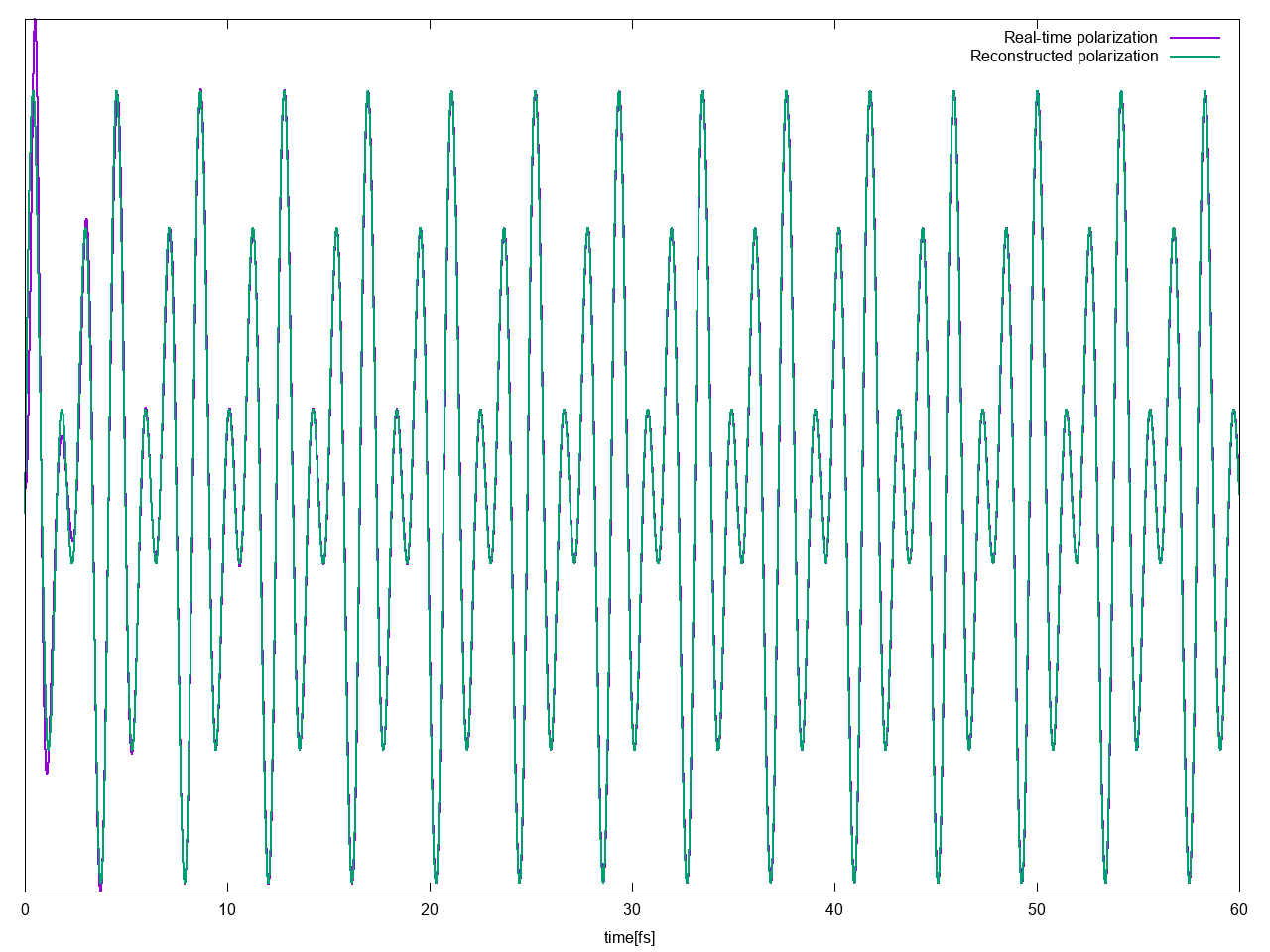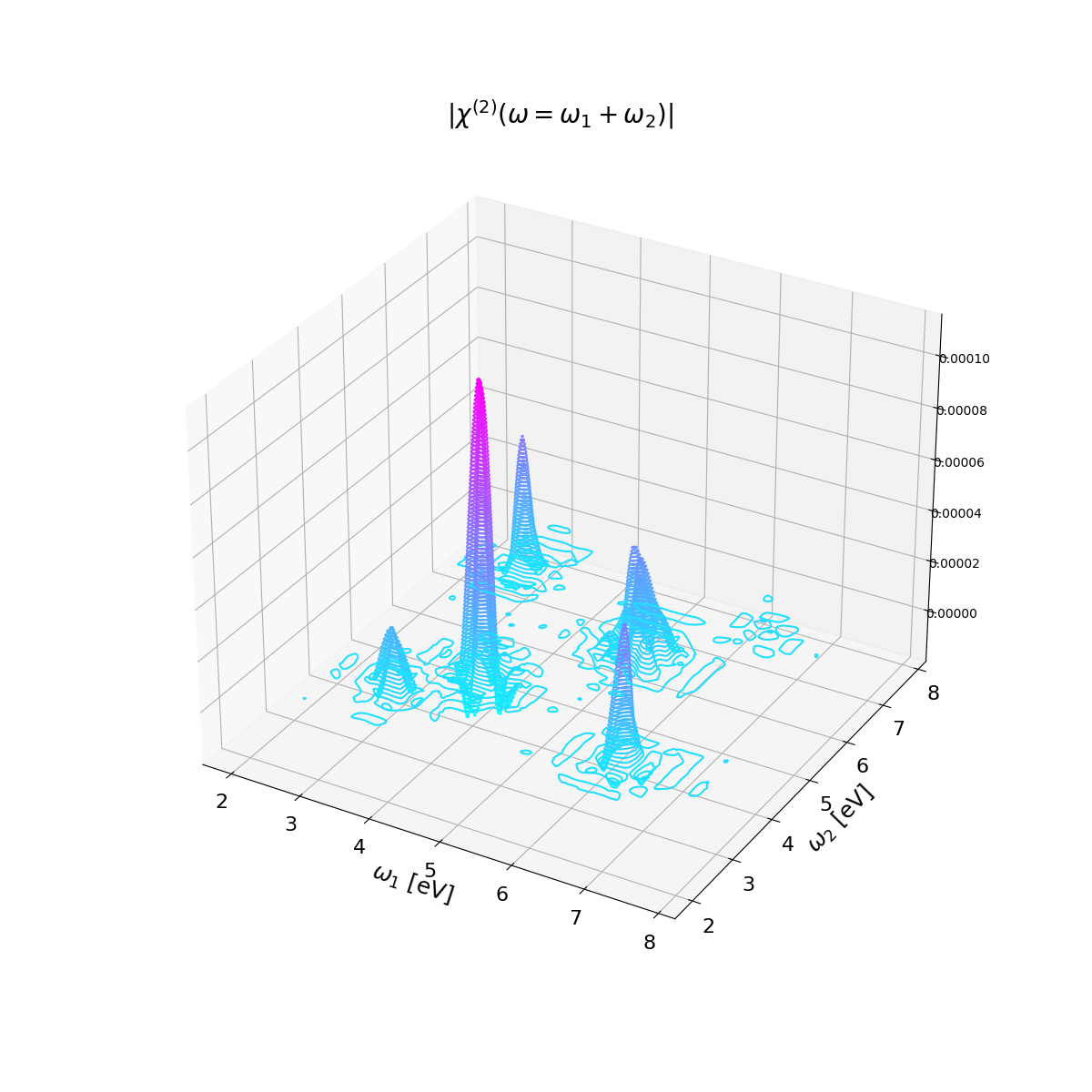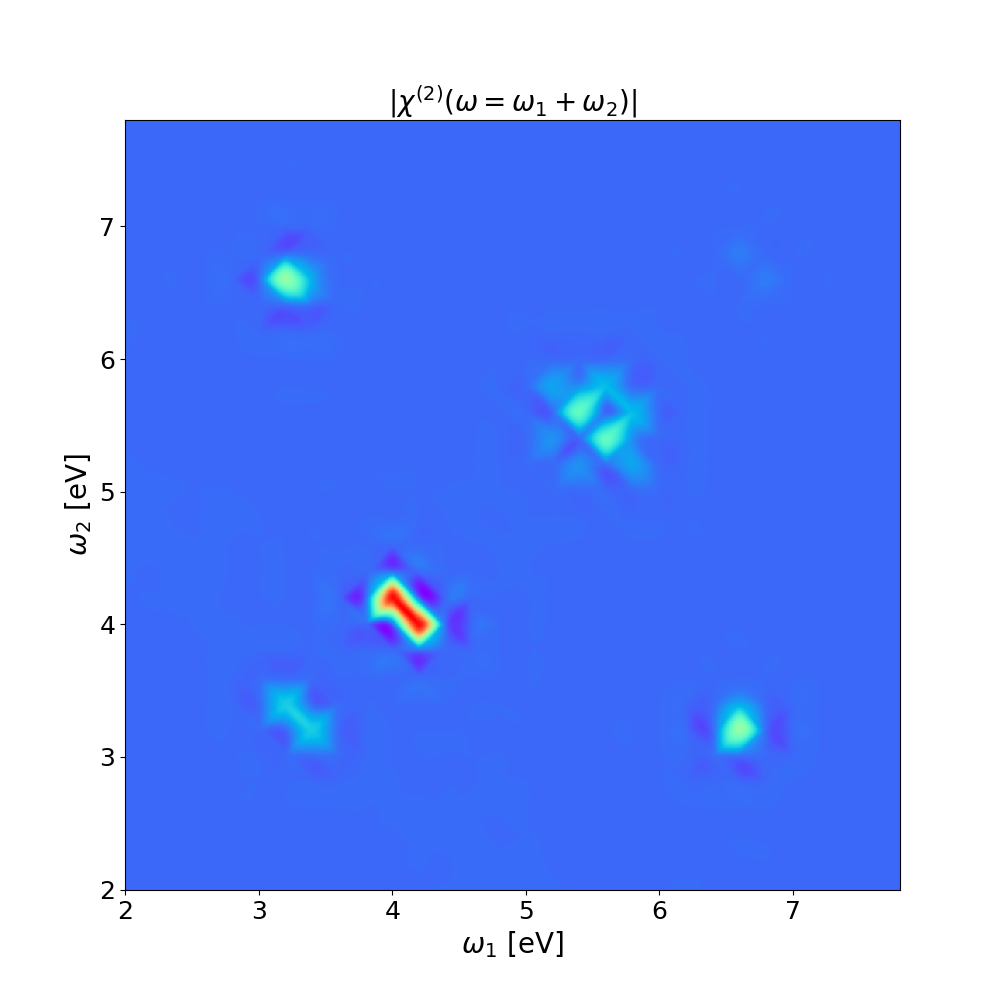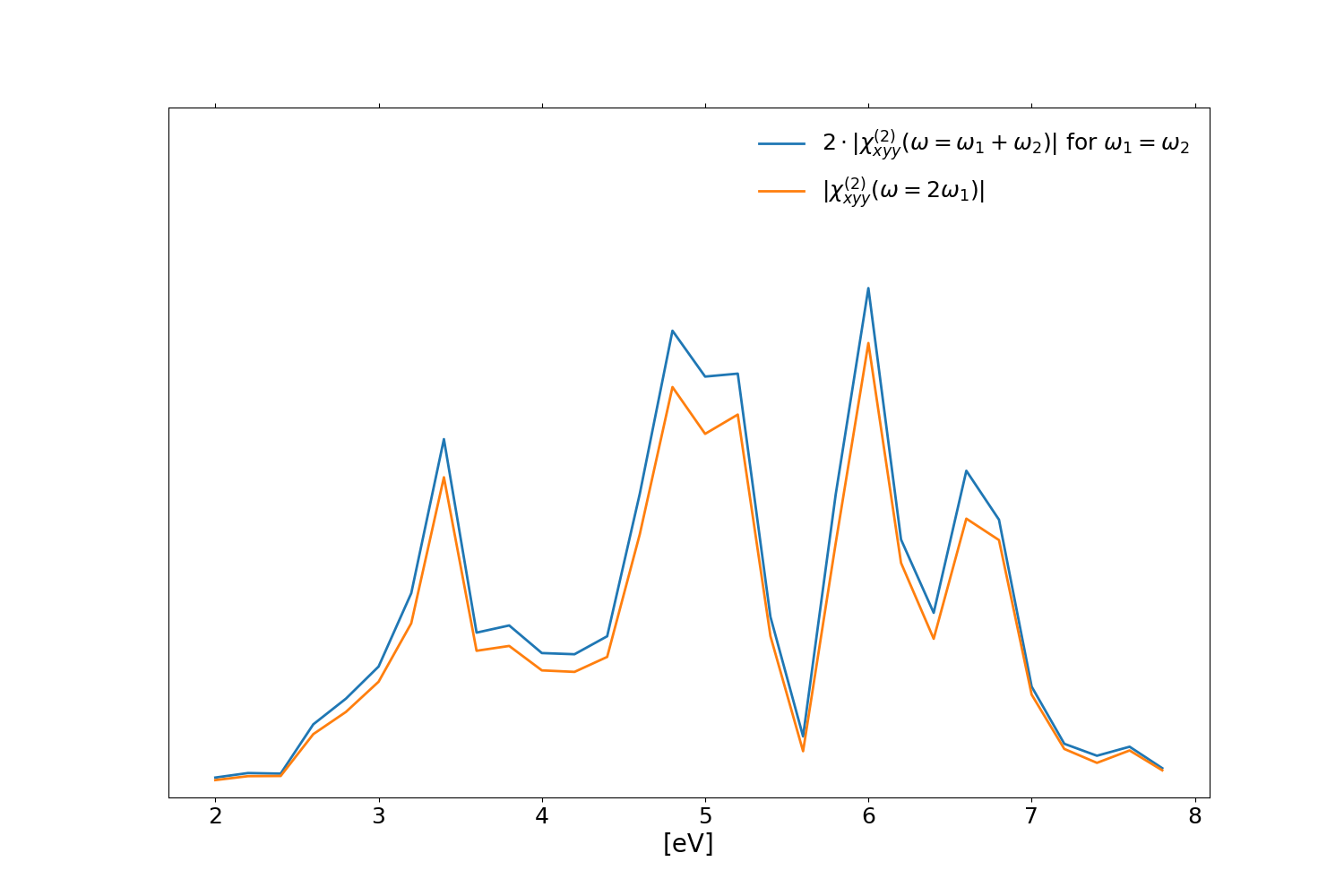Sum frequency generation: Difference between revisions
No edit summary |
|||
| (18 intermediate revisions by the same user not shown) | |||
| Line 1: | Line 1: | ||
[[File:Sum frequency.jpg|right|500px |Sum frequency generation]] | [[File:Sum frequency.jpg|right|500px |Sum frequency generation]] | ||
'''This tutorial is for internal use only, these response functions are not implemented/tested in yambo/yambopy suite.''' | |||
In this tutorial we will show how to calculate Sum Frequency Generation(SFG) and also Difference Frequency Generation (DFG) in bulk materials.<br> | In this tutorial we will show how to calculate Sum Frequency Generation(SFG) and also Difference Frequency Generation (DFG) in bulk materials.<br> | ||
| Line 114: | Line 116: | ||
etc.... | etc.... | ||
for example we can plot the 2 and 3 columns of the file <code>o.YamboPy-SF_probe_order_1_1</code> that corresponds to the <math>\chi^{(2)}(\omega=\omega_1+\omega_2) for <math>\omega_2 =3.0~eV</math> | for example we can plot the 2 and 3 columns of the file <code>o.YamboPy-SF_probe_order_1_1</code> that corresponds to the <math>\chi^{(2)}_{xyy} (\omega=\omega_1+\omega_2)</math> for <math>\omega_2 =3.0~eV</math>: | ||
[[File:Xhi2 11.png|center | 700px |xhi11]] | [[File:Xhi2 11.png|center | 700px |xhi11]] | ||
Here the python script used to generate the previous figure: [https://www.attaccalite.com/tutorials_yambo/plot_xhi2_monolayer.py plot_xhi2_monolayer.py] | |||
=== Checking the Fourier analysis=== | === Checking the Fourier analysis=== | ||
| Line 123: | Line 127: | ||
[[File:Sampling vs p.png|center| 700px |sampling_p]] | [[File:Sampling vs p.png|center| 700px |sampling_p]] | ||
Then you can check if real-time polarization is well reconstructed by the Fourier coefficients calculated by the script by plotting vs <code>o-TEST.polarization_F1</code> | Then you can check if real-time polarization is well reconstructed by the Fourier coefficients calculated by the script by plotting <code> o.YamboPy-pol_reconstructed_F1</code> vs <code>o-TEST.polarization_F1</code> | ||
[[File:Reconstructed p vs p.png|center |700px |Reconstructed polarization]] | [[File:Reconstructed p vs p.png|center |700px |Reconstructed polarization]] | ||
| Line 138: | Line 142: | ||
Calculations will take some time, in the above example we parallelized on 10 cores to speed up them. <br> | Calculations will take some time, in the above example we parallelized on 10 cores to speed up them. <br> | ||
When the calculations are terminated you will find many folders called EF1, EF2, ... EF29. These folders are generated from the loop on the second field frequency(Field2_Freq), and each one contains the response real-time polarization at 30 different frequencies of the first external field (Field1_Freq). | When the calculations are terminated you will find many folders called EF1, EF2, ... EF29. These folders are generated from the loop on the second field frequency(Field2_Freq), and each one contains the response real-time polarization at 30 different frequencies of the first external field (Field1_Freq). | ||
Now we will use a script to read all the real-time polarization, Fourier analyze them as it was done in the previous section for a single one, and the write the <math>\chi^{(2)}(\omega=\omega_1 + \omega_2)</math> in a file in the form: <math>\omega_1 , \omega_2, Re \{\chi^{(2)}\} , Im \{\chi^{(2)}\}</math>. | Now we will use a script to read all the real-time polarization, Fourier analyze them as it was done in the previous section for a single one, and the write the <math>\chi^{(2)}(\omega=\omega_1 + \omega_2)</math> in a file in the form: <math>\omega_1 , \omega_2, Re \{\chi^{(2)}\} , Im \{\chi^{(2)}\}</math>. | ||
[https://www.attaccalite.com/tutorials_yambo/analysis_sfg.py analysis_sfg.py] | |||
[https://www.attaccalite.com/tutorials_yambo/ | then we can interpolate the results <math>\chi^{(2)}(\omega)</math> and plot results in 3D or 2D: [https://www.attaccalite.com/tutorials_yambo/plot_xhi_2d.py plot_xhi_2d.py], [https://www.attaccalite.com/tutorials_yambo/plot_xhi_3d.py plot_xhi_3d.py] | ||
[[File:SFG 3D.png|center | 700px|SFG 3D]] | [[File:SFG 3D.png|center | 700px|SFG 3D]] | ||
| Line 151: | Line 154: | ||
== Comparison with SHG == | == Comparison with SHG == | ||
Finally you can compare the diagonal of <math>\chi^{(2)}(\omega=\omega_1 +\omega_2)</math>, when <math>\omega_1 =\omega_2</math>, with the standard second harmonic generation <math>\chi^{(2)}(\omega=2 \omega_1)</math> calculated as explained in the tutorial [[Real time approach to non-linear response (SHG)]]: | |||
[[File:Xhi2 vs xhi2.png|center | 700px|xhi2_vs_xhi2]] | |||
Notice that there is factor two between the two response functions, this is the so-called degeneracy factor, for more details see Sec. 1.3 in Ref.<ref>Boyd, Robert W., Alexander L. Gaeta, and Enno Giese. "Nonlinear optics." Springer Handbook of Atomic, Molecular, and Optical Physics. Cham: Springer International Publishing, 1097-1110.(2008)</ref>. The small differences between the two spectra are given the different sampling strategies of the <code>SF_Harmonic_Analysis</code> function respect to the <code>Harmonic_Analysis</code> one. | |||
== Reference == | == Reference == | ||
Latest revision as of 08:09, 9 July 2024
This tutorial is for internal use only, these response functions are not implemented/tested in yambo/yambopy suite.
In this tutorial we will show how to calculate Sum Frequency Generation(SFG) and also Difference Frequency Generation (DFG) in bulk materials.
We suppose you are already familiar with the non-linear response using the Yambo code.
If it is not the case please study the previous tutorials:
Linear response using Dynamical Berry Phase and Real time approach to non-linear response (SHG).
We thank Mike N. Pionteck for the script used in this tutorial.
DFT calculations
In this example, we will consider a single layer of hexagonal boron nitride (hBN). If you didn't before you can download input files and Yambo databases for this tutorial here: hBN-2D-RT.tar.gz. and/or follow the instructions to generate the databases here: Prerequisites for Real Time propagation with Yambo
Removing symmetries
In this tutorial we will calculate the SFG along when both fields are in the 'y' direction,
therefore we remove symmetries not compatible with an external field along this direction, with the command ypp_nl -y:
fixsyms # [R] Remove symmetries not consistent with an external perturbation % Efield1 0.000000 | 1.000000 | 0.000000 | # First external Electric Field % % Efield2 0.000000 | 0.000000 | 0.000000 | # Additional external Electric Field % BField= 0.000000 T # [MAG] Magnetic field modulus Bpsi= 0.000000 deg # [MAG] Magnetic field psi angle [degree] Btheta= 0.000000 deg # [MAG] Magnetic field theta angle [degree] #RmAllSymm # Remove all symmetries RmTimeRev # Remove Time Reversal #RmSpaceInv # Remove Spatial Inversion
Real-time simulation with two external fields
You go in the FixSymm folder and run again the setup. Then you can put the following input file, that has been generated with the command yambo_nl -u n , in the folder with the name yambo.in_sfg:
nloptics # [R] Non-linear spectroscopy
NLogCPUs=0 # [PARALLEL] Live-timing CPU`s (0 for all)
PAR_def_mode= "balanced" # [PARALLEL] Default distribution mode ("balanced"/"memory"/"workload"/"KQmemory")
NL_CPU= "10 1" # [PARALLEL] CPUs for each role
NL_ROLEs= "w k" # [PARALLEL] CPUs roles (w,k)
DIP_CPU= "" # [PARALLEL] CPUs for each role
DIP_ROLEs= "" # [PARALLEL] CPUs roles (k,c,v)
DIP_Threads=0 # [OPENMP/X] Number of threads for dipoles
NL_Threads=0 # [OPENMP/NL] Number of threads for nl-optics
% NLBands
3 | 6 | # [NL] Bands range
%
NLverbosity= "high" # [NL] Verbosity level (low | high)
NLtime= 60.00000 fs # [NL] Simulation Time
NLintegrator= "CRANKNIC" # [NL] Integrator ("EULEREXP/RK2/RK4/RK2EXP/HEUN/INVINT/CRANKNIC")
NLCorrelation= "IPA" # [NL] Correlation ("IPA/HARTREE/TDDFT/LRC/LRW/JGM/SEX")
NLLrcAlpha= 0.000000 # [NL] Long Range Correction
% NLEnRange
2.000000 | 8.000000 | eV # [NL] Energy range (for loop on frequencies NLEnSteps/=0
%
NLEnSteps= 30 # [NL] Energy steps for the loop on frequencies
% NLrotaxis
0.000000 | 0.000000 | 0.000000 | # [NL] Rotation axis (for the loop on angles NLAngSteps/=0)
%
NLAngSteps=0 # [NL] Angular steps (if NLAngSteps/=0 field versor will be ignored)
NLDamping= 0.200000 eV # [NL] Damping (or dephasing)
RADLifeTime=-1.000000 fs # [RT] Radiative life-time (if negative Yambo sets it equal to Phase_LifeTime in NL)
#EvalCurrent # [NL] Evaluate the current
#FrPolPerdic # [DIP] Force periodicity of polarization respect to the external field
HARRLvcs= 18475 RL # [HA] Hartree RL components
EXXRLvcs= 18475 RL # [XX] Exchange RL components
% Field1_Freq
-0.100000 |-0.100000 | eV # [RT Field1] Frequency
%
Field1_NFreqs= 1 # [RT Field1] Frequency
Field1_Int= 1000.00 kWLm2 # [RT Field1] Intensity
Field1_Width= 0.000000 fs # [RT Field1] Width
Field1_kind= " SOFTSIN" # [RT Field1] Kind(SIN|SOFTSIN| see more on src/modules/mod_fields.F)
Field1_pol= "linear" # [RT Field1] Pol(linear|circular)
% Field1_Dir
0.000000 | 1.000000 | 0.000000 | # [RT Field1] Versor
%
Field1_Tstart= 0.010000 fs # [RT Field1] Initial Time
% Field2_Freq
3.000000 | 3.000000 | eV # [RT Field2] Frequency
%
Field2_NFreqs= 1 # [RT Field2] Frequency
Field2_Int= 1000.00 kWLm2 # [RT Field2] Intensity
Field2_Width= 0.000000 fs # [RT Field2] Width
Field2_kind= " SOFTSIN" # [RT Field2] Kind(SIN|SOFTSIN| see more on src/modules/mod_fields.F)
Field2_pol= "linear" # [RT Field2] Pol(linear|circular)
% Field2_Dir
0.000000 | 1.000000 | 0.000000 | # [RT Field2] Versor
%
Field2_Tstart= 0.010000 fs # [RT Field2] Initial Time
If you run this input file with the command yambo_nl -F yambo.in_sfg, the code will run 30 simulations for a first laser field with frequency between 2.0 and 8.0 while the frequency of the second field is fixed at 3.0 eV. For this reason we provide you a simple python script to change also the frequency of the second field (in blue in the input).
In the next section we will show how to analyse the non-linear response generated by the presence of two external fields.
Analysis of the single run
We will use an extension to two fields of the approach described in Ref. [1] and used for the tutorials on second/third harmonic generation: Real time approach to non-linear response (SHG). These new subroutine are available in the new YamboPy package. Hereafter the pythonn script for the analysis:
from yambopy import * from yambopy.nl.sum_frequencies import SF_Harmonic_Analysis from yambopy.units import fs2aut X_order=4 NLDB=YamboNLDB(calc='TEST') SF_Harmonic_Analysis(NLDB,X_order=X_order,T_range=[50.0*fs2aut,-1.0],prn_Peff=True,prn_Xhi=True)
Notice that we set the beginning of time range where analysis is performed with the variable T_range=[50.0*fs2aut,-1.0], you can also omit this variable and the code automatically will set the optimal range for the analysis using the damping given in input in the real-time simulation.
This script will analyse the real-time response and produce all the different [math]\displaystyle{ \chi^{(n)}(\omega) }[/math] in the form:
o.YamboPy-SF_probe_order_1_0 ==> [math]\displaystyle{ \chi^{(1)}(\omega=\omega_1) }[/math]
o.YamboPy-SF_probe_order_1_1 ==> [math]\displaystyle{ \chi^{(2)}(\omega=\omega_1+\omega_2) }[/math]
o.YamboPy-SF_probe_order_2_0 ==> [math]\displaystyle{ \chi^{(2)}(\omega=2\omega_1) }[/math]
o.YamboPy-SF_probe_order_0_2 ==> [math]\displaystyle{ \chi^{(2)}(\omega=2\omega_2) }[/math]
o.YamboPy-SF_probe_order_1_2 ==> [math]\displaystyle{ \chi^{(3)}(\omega=\omega_1+2\omega_2) }[/math]
o.YamboPy-SF_probe_order_2_2 ==> [math]\displaystyle{ \chi^{(4)}(\omega=2\omega_1+2\omega_2) }[/math]
etc....
for example we can plot the 2 and 3 columns of the file o.YamboPy-SF_probe_order_1_1 that corresponds to the [math]\displaystyle{ \chi^{(2)}_{xyy} (\omega=\omega_1+\omega_2) }[/math] for [math]\displaystyle{ \omega_2 =3.0~eV }[/math]:
Here the python script used to generate the previous figure: plot_xhi2_monolayer.py
Checking the Fourier analysis
In the previous script we turned on the flag prn_Peff=True that automatically will produce a series of file to check if the Fourier was successful.
The files o.YamboPy-sampling_FX contain the sampling points used to fix the real-time polarization, you can for example plot o.YamboPy-sampling_F1 vs o-TEST.polarization_F1 together to see which part of [math]\displaystyle{ P(t) }[/math] is used to extract the response functions:
Then you can check if real-time polarization is well reconstructed by the Fourier coefficients calculated by the script by plotting o.YamboPy-pol_reconstructed_F1 vs o-TEST.polarization_F1
As you see the polarization is well reconstructed starting from the extracted Fourier coefficients, expect for the beginning, but this is normal because the initial signal is affected by the internal eigen--modes of the systems that later are washed out by the de-phasing. For this reason we use only the last part of the signal for the analysis, for more details see Ref. [1]
Analysis of all runs
For this reason we provide you a simple python script to change also the frequency of the second field (in blue in the input).
please modify the python script by set the correct path of your executable, the parallelization and the number of frequency steps you are interested in. In this example we will do 30 frequency steps for both the first (in the Yambo input) and the second field (in the python script).
Calculations will take some time, in the above example we parallelized on 10 cores to speed up them.
When the calculations are terminated you will find many folders called EF1, EF2, ... EF29. These folders are generated from the loop on the second field frequency(Field2_Freq), and each one contains the response real-time polarization at 30 different frequencies of the first external field (Field1_Freq).
Now we will use a script to read all the real-time polarization, Fourier analyze them as it was done in the previous section for a single one, and the write the [math]\displaystyle{ \chi^{(2)}(\omega=\omega_1 + \omega_2) }[/math] in a file in the form: [math]\displaystyle{ \omega_1 , \omega_2, Re \{\chi^{(2)}\} , Im \{\chi^{(2)}\} }[/math].
then we can interpolate the results [math]\displaystyle{ \chi^{(2)}(\omega) }[/math] and plot results in 3D or 2D: plot_xhi_2d.py, plot_xhi_3d.py
Comparison with SHG
Finally you can compare the diagonal of [math]\displaystyle{ \chi^{(2)}(\omega=\omega_1 +\omega_2) }[/math], when [math]\displaystyle{ \omega_1 =\omega_2 }[/math], with the standard second harmonic generation [math]\displaystyle{ \chi^{(2)}(\omega=2 \omega_1) }[/math] calculated as explained in the tutorial Real time approach to non-linear response (SHG):
Notice that there is factor two between the two response functions, this is the so-called degeneracy factor, for more details see Sec. 1.3 in Ref.[2]. The small differences between the two spectra are given the different sampling strategies of the SF_Harmonic_Analysis function respect to the Harmonic_Analysis one.
Reference
- ↑ 1.0 1.1 Nonlinear optics from an ab initio approach by means of the dynamical Berry phase: Application to second- and third-harmonic generation in semiconductors, C. Attaccalite and M. Grüning, Phys. Rev. B 88, 235113(2013)
- ↑ Boyd, Robert W., Alexander L. Gaeta, and Enno Giese. "Nonlinear optics." Springer Handbook of Atomic, Molecular, and Optical Physics. Cham: Springer International Publishing, 1097-1110.(2008)
